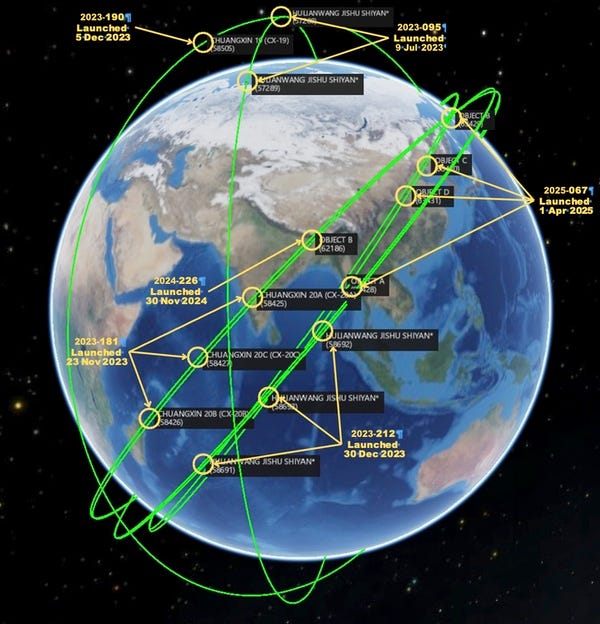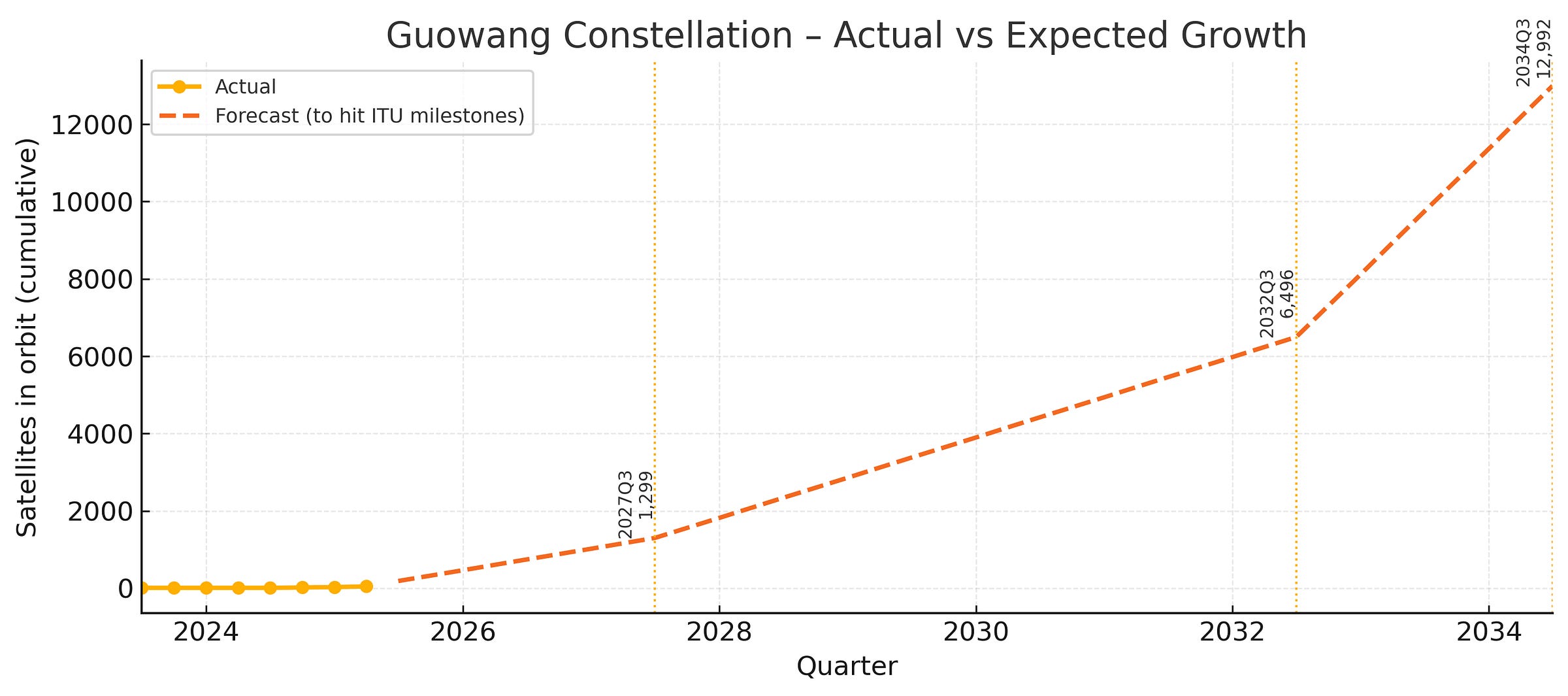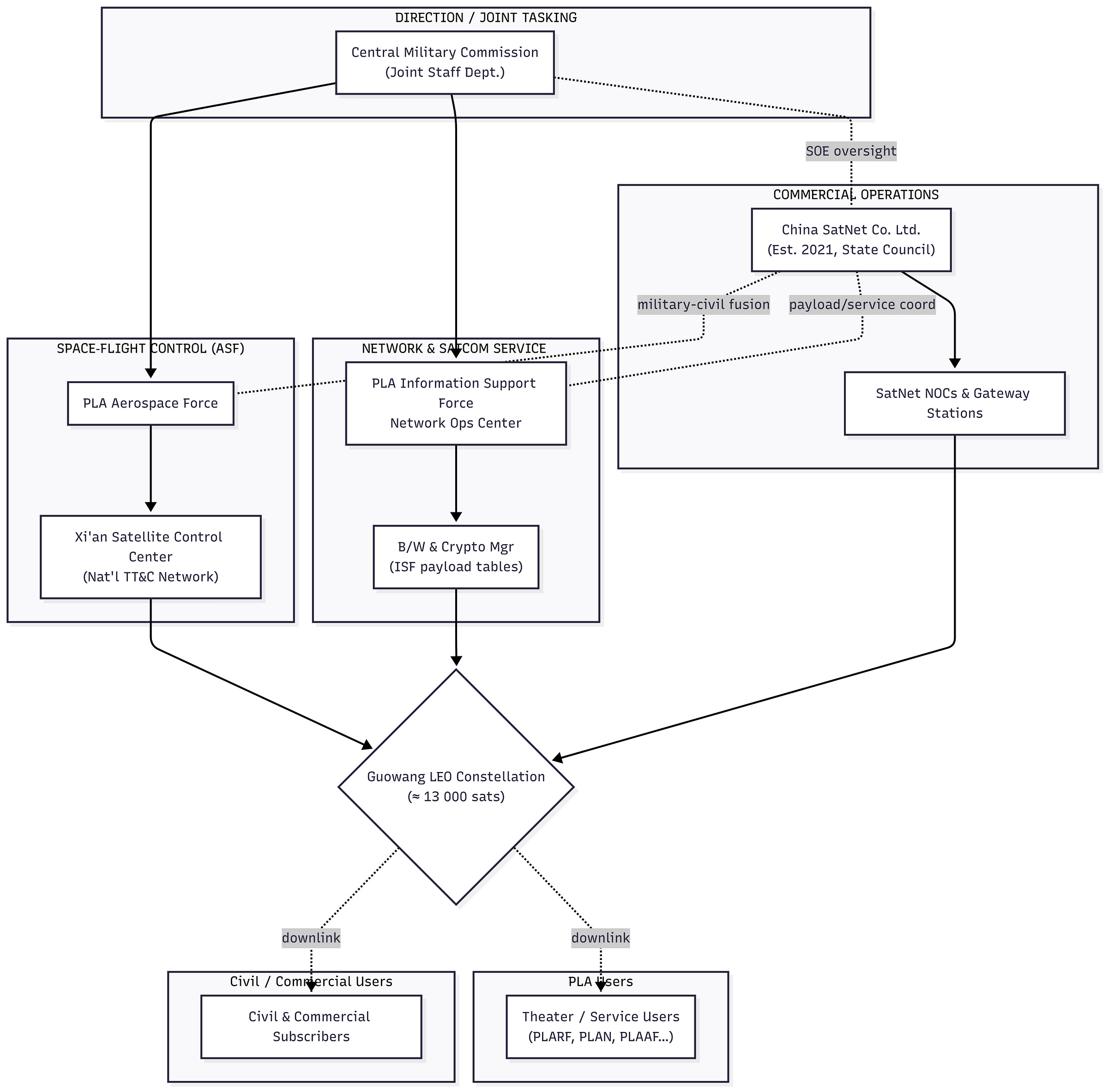The Military Implications of China's Guowang Megaconstellation
Architecture, Ambition, and the PLA's Future in Low-Earth Orbit
In my previous post on Chinese military satellite communications, I detailed the PLA’s long-standing reliance on a limited number of geosynchronous (GEO) satellites. This architecture, while functional, presents a significant vulnerability. High-value, slow-moving satellites in predictable orbits are prime targets in a potential conflict. Beijing knows this. For years, Chinese strategists have watched the development of Western low-Earth orbit (LEO) constellations with a mixture of envy and alarm. Now, China is fielding its own megaconstellation, “Guowang” (国网).
Guowang is far more than a commercial broadband venture; it is a foundational component of the PLA’s vision for future warfare, designed from the ground up to enable multi-domain precision combat and dismantle the information superiority the United States has long taken for granted.

Why Guowang, Why Now?
The Guowang (国网), or “National Satellite Internet,” program was born out of strategic necessity. The project entered the International Telecommunication Union (ITU) coordination queue in September 2020; Russia’s 2022 invasion of Ukraine and Starlink’s battlefield role accelerated work. PLA observers saw firsthand how a resilient, proliferated LEO network could provide critical battlefield communications even under attack. This underscored the strategic value of a space-based internet network for military operations and accelerated China’s own plans.
The project is driven by a powerful mix of strategic motivations. Domestically, it aligns with China’s “Network Power” (网络强国) strategy, aiming to bridge the digital divide in remote western regions like Tibet and Xinjiang. Internationally, it is a pillar of the Digital Silk Road, a way for China to extend its influence and bind developing nations to its technological ecosystem.
More pointedly, Guowang is a direct response to what Chinese analysts see as an attempt by the West to monopolize LEO resources. They frequently echo the ITU’s principle of “first-come, first-served,” translated as “先登先占.” With SpaceX planning for over 40,000 satellites, Beijing felt compelled to act decisively to secure its own orbital and spectrum resources before they were all claimed. This led to the establishment in 2021 of the China Satellite Network Group Co., or “China SatNet,” a central state-owned enterprise tasked with consolidating previous, disparate LEO efforts—most notably CASIC’s Hongyan (鸿雁) and CASC’s Hongyun (鸿云) projects—and spearheading Guowang’s development as the “national team” (国家队).

The Ambitious Architecture
Guowang’s planned scale is immense. According to filings with the ITU, the full constellation will consist of 12,992 satellites. This network is divided into two primary sub-constellations to provide layered coverage.
The VLEO Layer (GW-A59): This shell consists of 6,080 satellites in very low-Earth orbit (VLEO) at altitudes between 300 and 500 km. Their proximity to Earth enables extremely low-latency links (potentially under 30 milliseconds), critical for time-sensitive military applications like controlling hypersonic weapons or swarms of unmanned systems.
The LEO Layer (GW-A2): A larger shell of 6,912 satellites will orbit higher, at approximately 1,145 km. This layer provides broad, persistent global coverage, acting as the network's backbone and reducing the number of ground stations required for continuous service.

The system’s radio frequency architecture is ambitious. ITU filings show it will use high-frequency bands for its primary communication links: 37.5-42.5 GHz for space-to-ground downlinks and 47.2-51.4 GHz for ground-to-space uplinks. These bands, often called Q/V-band, were likely chosen because the more common Ku and Ka bands are already heavily congested. Operating in V-band offers enormous bandwidth but presents significant engineering challenges, demanding advanced radio frequency front-ends and sophisticated coding to mitigate atmospheric interference like rain-fade. While not confirmed in open-source filings, the satellites almost certainly will carry dedicated, encrypted military payloads, likely using the X-band and other military-specific frequencies for secure PLA command and control, consistent with global military SATCOM practice.
The most critical technological enabler is the planned use of laser inter-satellite links (星间激光链路). These laser links are a geopolitical and military necessity for China. Unlike the United States, China lacks a robust global network of ground stations in allied territories. A purely RF-dependent system would force the PLA to downlink sensitive data in neutral or potentially hostile countries—a non-starter for military operations. Laser ISLs, with data rates of 10 Gbps or higher, solve this problem. They allow data to be routed across the orbital mesh network and only downlinked over secure ground stations within China’s borders. This gives the PLA the operational autonomy required for independent global power projection.
Military-Civil Fusion:
Guowang is a textbook example of China’s military-civil fusion (军民融合) strategy. The integration of this commercial system into the PLA’s warfighting architecture is deep and multi-layered. While China SatNet is a civilian company, the PLA’s requirements for secure, resilient, and prioritized communications are embedded in the system’s DNA.
The command-and-control (C2) structure exemplifies this fusion. The day-to-day Telemetry, Tracking, and Control (TT&C) of the constellation—managing satellite health, orbits, and commercial data traffic—is the responsibility of China SatNet. However, the PLA maintains parallel and, in a conflict, overriding C2. Following the 2024 PLA reforms, this is a shared responsibility: the Aerospace Force (ASF) manages the physical satellites (TT&C, orbital station-keeping), likely via the Xi’an Satellite Control Center. The Information Support Force (ISF) manages the network data itself. The ISF likely can task satellite payloads, dynamically re-route traffic, and allocate dedicated, high-priority bandwidth for military operations. In a crisis, the ISF could commandeer entire segments of the network for exclusive military use, effectively turning a commercial utility into a strategic weapon.

The integration into PLA datalinks occurs at the ground segment. Data downlinked from Guowang satellites arrives at strategically located gateway stations (信关站). These gateways serve as the bridge to terrestrial fiber-optic networks. For military data, these gateways have direct, secure connections to the PLA’s national command networks. The traffic would never touch the public internet. It would be piped through dedicated military fiber lines to theater commands, Rocket Force launch brigades, and naval bases. At the tactical edge, PLA units would not use commercial user terminals. Instead, they would be equipped with ruggedized, military-specific terminals for vehicles, ships, and aircraft. These terminals would be capable of using low-probability-of-intercept/detection (LPI/LPD) waveforms to minimize their electronic signature and avoid enemy targeting.
Use Case 1: Long-Range Fires
The PLA Rocket Force’s anti-ship ballistic missiles, like the DF-21D, are central to its A2/AD strategy. The effectiveness of these weapons, however, depends entirely on the ability to find, fix, track, and target a moving U.S. aircraft carrier. This “kill chain” requires a resilient, low-latency data link.
Guowang is being engineered to be that link. Imagine a PLA reconnaissance drone with a high-resolution sensor detects a U.S. naval task force. With Guowang, it can use a high-bandwidth Ka-band uplink to transmit high-definition video in near real-time through the LEO network. The data is routed via laser ISLs to a satellite passing over a secure gateway in Xinjiang, where it is downlinked directly into the PLA’s command network. This targeting data is then relayed to a mobile missile launcher within mainland China. The VLEO shell’s low latency dramatically shortens the sensor-to-shooter timeline, a critical factor when engaging a moving target.

Use Case 2: Commanding a Blue-Water Navy
As the PLA Navy (PLAN) pushes into the Indian Ocean and beyond, it faces a significant command and control challenge. Guowang provides a sovereign-controlled network to meet this need. A PLAN destroyer operating near the Horn of Africa could use its shipborne military terminal to establish a secure X-band link, allowing it to conduct encrypted video conferences with fleet headquarters, download large intelligence files, and coordinate operations without relying on foreign commercial satellites.
Headwinds and Hurdles
Despite top-level backing, Guowang faces significant industrial, launch, and technological pressure.
Industrial Scale-Up: China’s space industry is shifting from bespoke, artisanal satellite production to assembly-line mass manufacturing. Key state-owned players like CASC and CASIC, along with commercial entrants like Geely (via its subsidiary Geespace) and Commsat, are racing to build factories capable of producing hundreds of satellites per year. Mass-producing complex components like phased-array antennas, V-band RF front-ends, and high-precision laser terminals at cost and quality has no precedent in China.
Launch Cadence: As of July 2025, only an estimated 40-50 Guowang satellites are in orbit. To meet the ITU “bringing-into-use” milestone of roughly 1,300 satellites (10%) by the September 2027 deadline, China must dramatically accelerate its launch rate. Its current Long March rocket family is reliable but largely expendable, making its cost-per-kilogram to orbit far higher than SpaceX’s reusable Falcon 9. The deployment and replenishment of Guowang hinges on the timely success of new reusable rockets, like the Long March 9 or commercial methalox boosters from firms like LandSpace.
Technological and Business Viability: Mastering laser ISL networking across thousands of constantly moving nodes is a monumental software and engineering challenge. Furthermore, the business case for any megaconstellation is fraught. The project’s “high investment, long cycle” (高投入, 长周期) nature means it will almost certainly require continuous state subsidies to remain solvent, regardless of its commercial revenue.
Implications for the United States
A fully operational Guowang would narrow the C4ISR gap and reshape Indo‑Pacific deterrence dynamics. It would provide the PLA with a resilient C4ISR network, eroding the information dominance that has been a cornerstone of U.S. military power.
However, the system also presents vulnerabilities. A network of thousands of satellites and ground stations creates a vastly expanded “attack surface” for cyber and electronic warfare. The U.S. and its allies will undoubtedly develop capabilities to target Guowang’s ground-based infrastructure and exploit its network protocols. The U.S. is already building its own military-focused LEO system, the Space Development Agency’s Proliferated Warfighter Space Architecture (PWSA), as a direct counter.
The contest in LEO is well underway. It will not be won by a single knockout blow, but by a persistent struggle for network resilience and information control. While Guowang’s timeline may slip, the strategic imperative behind it ensures Beijing will pursue its completion with immense resolve. The result will be a new, contested domain of space-based information warfare, with profound implications for future global conflict.
Thanks for reading! I hope you enjoyed this post. As always, please subscribe to Orders and Observations and share my newsletter if you can, and follow me on X/Twitter and LinkedIn if you’d like to connect or collaborate.






Superb write up ...
This is awesome Mike. Thanks for continuing to impress with your analysis.